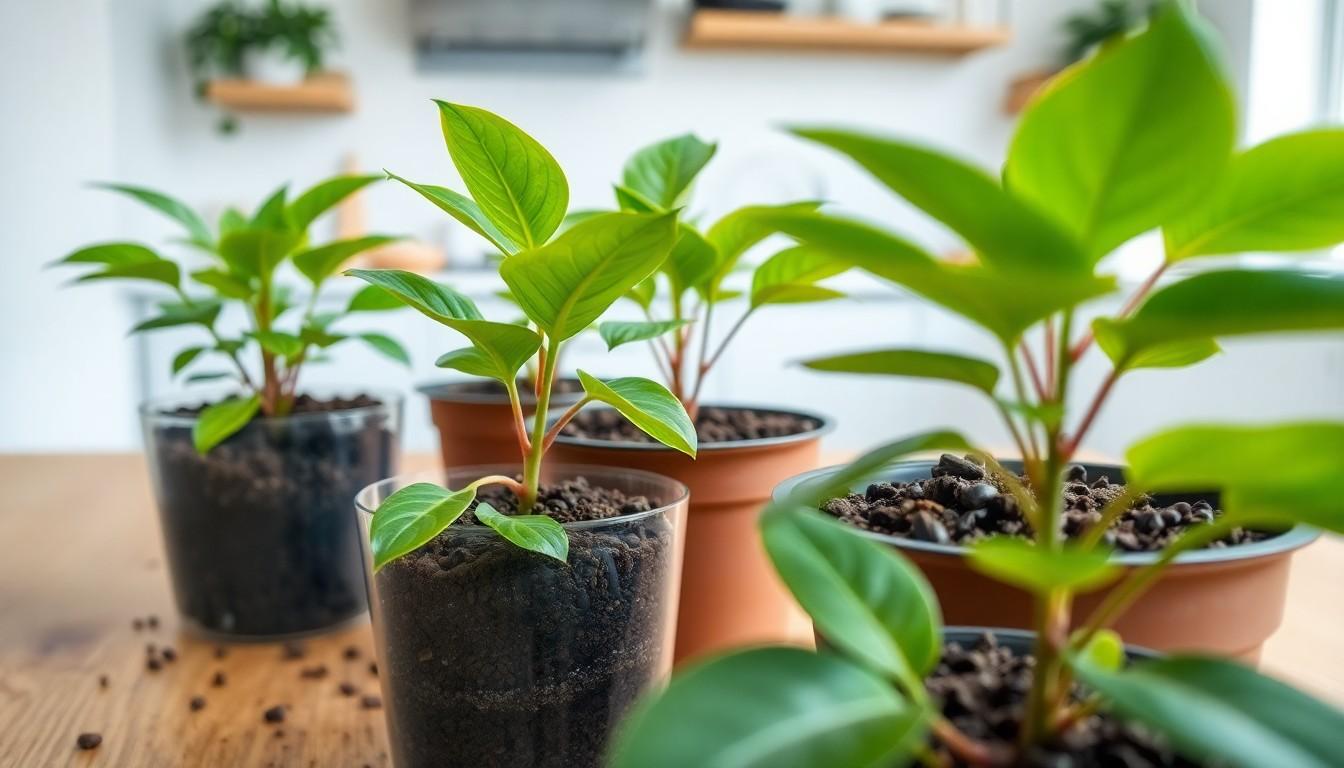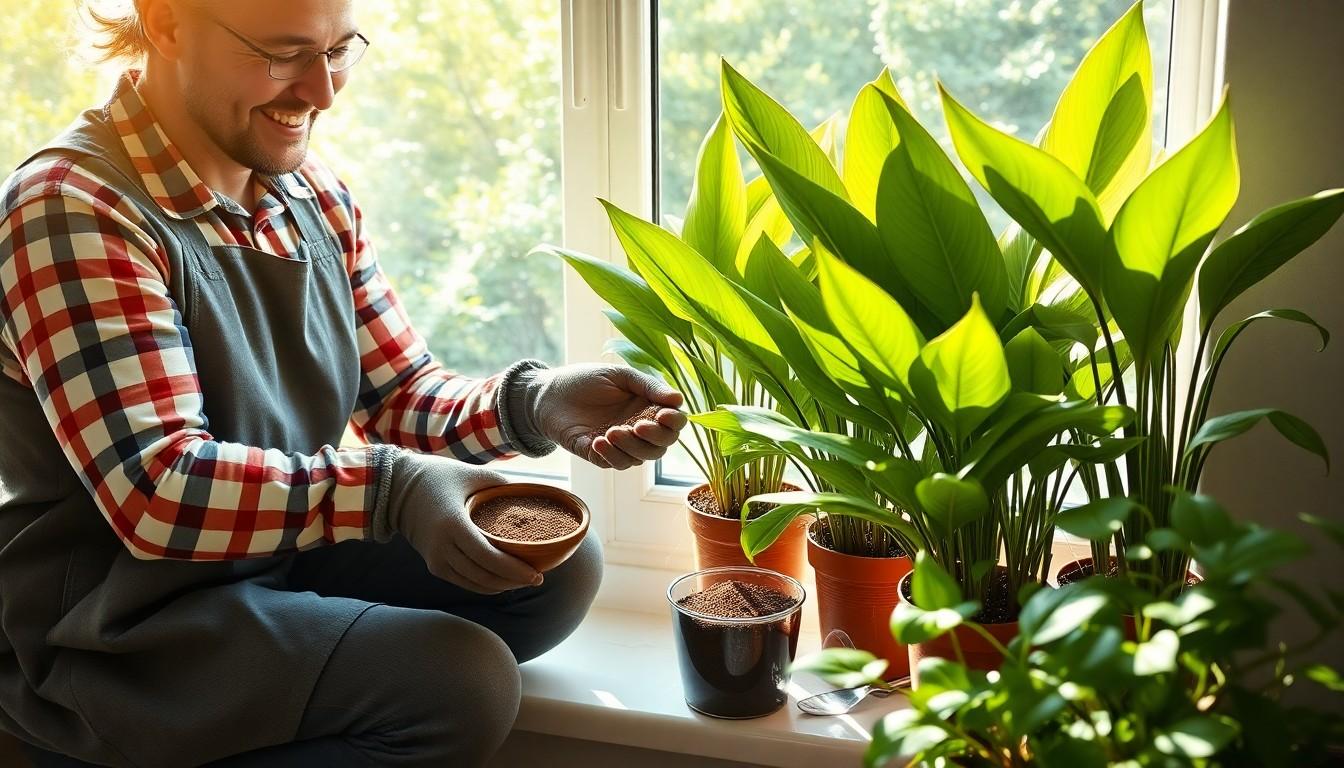Indoor plants can sometimes feel like they need a little extra love. What if the secret ingredient to their lushness is hiding in your kitchen? Enter coffee grounds—the magical remnants of your morning brew. Not only do they pack a punch of nutrients, but they also invite earthworms to the party. Who knew your plants could have a better social life than you?
Benefits of Coffee Grounds for Indoor Plants
Coffee grounds serve as an excellent resource for enhancing indoor plants’ growth. These grounds offer several advantages, from adding nutrients to improving soil structure.
Nutrient Content
Coffee grounds contain essential nutrients like nitrogen, phosphorus, and potassium. Nitrogen aids in leaf growth and overall vigor. Phosphorus promotes root development, while potassium supports flower and fruit formation. Their slow-release nature provides a steady nutrient supply, ensuring plants receive ongoing nourishment. Additionally, coffee grounds can improve the acidity of soil, benefiting acid-loving plants like azaleas and blueberries. Using these grounds can lead to greener, healthier indoor plants.
Soil Structure Improvement
Incorporating coffee grounds into potting soil enhances soil structure significantly. They help improve drainage by promoting aeration, allowing roots to access oxygen more effectively. Moreover, coffee grounds enhance water retention, aiding plants during dry spells. Their texture increases soil tilth, which promotes better root growth. A combination of these benefits fosters a more balanced environment for indoor plants. Ultimately, using coffee grounds not only nourishes plants but also creates an ideal growing medium.
How to Use Coffee Grounds Effectively

Utilizing coffee grounds can significantly enhance the health of indoor plants. Proper preparation and application techniques maximize their benefits.
Preparation Methods
Collect used coffee grounds from brewing. Allow the grounds to dry to reduce the risk of mold growth. Grinding the dried coffee grounds into finer particles improves nutrient accessibility. Mixing coffee grounds with worm castings creates a balanced fertilizer. Combine one part coffee grounds with one part worm castings for optimal results. Testing pH levels before mix addition helps ensure compatibility with specific plants. Store the prepared mixture in an airtight container to maintain freshness.
Application Techniques
Sprinkling coffee grounds directly onto the soil surface fosters nutrient delivery. Incorporating grounds into the potting mix enhances aeration and drainage. Watering plants after application helps activate the nutrients. Using coffee grounds every four to six weeks promotes steady nutrient release. Observing plant reactions allows for adjustments in quantity based on specific needs. Composting coffee grounds with other organic materials creates a rich soil amendment. Applying ground coffee in moderation prevents potential acidity issues, maintaining healthy pH levels for optimal plant growth.
Potential Risks of Coffee Grounds
Coffee grounds present potential risks for indoor plants. While they may offer benefits, understanding these risks helps ensure healthy growth.
pH Levels Consideration
Coffee grounds tend to be acidic, which can alter the pH levels of the soil over time. Certain plants thrive in specific pH levels; therefore, introducing coffee grounds may lead to unbalanced conditions. Testing soil pH frequently helps identify any shifts. Applying grounds excessively might create an overly acidic environment, harming plants that prefer neutral or alkaline conditions. It’s essential to mix coffee grounds with other materials to mitigate acidity and maintain a balanced pH level.
Impact on Plant Growth
Applying too many coffee grounds can negatively impact plant growth. High concentrations might suffocate roots by compacting the soil, as they can create a dense layer that restricts airflow. Additionally, mold growth may occur if the grounds remain moist for too long, which can introduce harmful pathogens. Monitoring the amount of coffee grounds added to indoor plants allows for a healthier growth environment. Regularly mixing coffee grounds with other soil amendments ensures optimal nutrient availability and promotes healthy plants.
Best Indoor Plants to Use Coffee Grounds With
Certain indoor plants thrive when coffee grounds are incorporated into their care routine. These plants enjoy the nutrient boost provided by coffee grounds.
1. African Violets
African violets benefit from the balanced nutrients coffee grounds offer. Regular application can promote vibrant blooms and healthy foliage.
2. Peace Lily
Peace lilies appreciate the added nitrogen coffee grounds deliver. They also thrive in slightly acidic soil, making this pairing advantageous.
3. Geraniums
Geraniums respond well to coffee grounds, which enhance their growth and flowering. Mixing the grounds into the soil can lead to more robust plants.
4. Spider Plants
Spider plants enjoy the nutrient-rich environment created by coffee grounds. It helps improve soil aeration and retains moisture effectively.
5. Ferns
Ferns, particularly those that prefer humidity, benefit from the properties of coffee grounds. These grounds aid in maintaining soil moisture levels.
6. Pothos
Pothos plants flourish with the essential nutrients from coffee grounds. This popular houseplant thrives under various conditions, and coffee grounds enhance its adaptability.
7. Snake Plant
Snake plants can benefit from the addition of coffee grounds. While these plants are drought-tolerant, a little nutrient boost can promote healthier growth.
Apply coffee grounds sparingly and monitor plant response. They can enhance the growth of several indoor plants, but individual needs may vary.
Conclusion
Using coffee grounds for indoor plants can be a game-changer for plant enthusiasts. They offer a natural way to enrich soil with nutrients while improving overall plant vitality. With the right approach and moderation, coffee grounds can significantly boost the health of various indoor plants.
However, it’s crucial to monitor soil pH and avoid over-application to prevent any negative effects. By understanding each plant’s specific needs and adjusting the use of coffee grounds accordingly, indoor gardeners can create a thriving environment for their green companions. This simple addition to plant care can lead to lush growth and vibrant blooms, making indoor gardening even more rewarding.

